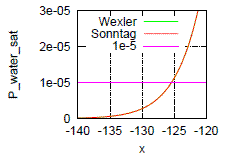I've been tried to make my implementation of Ostrowski's method to be able to solve the water saturation pressure related equations, as you shown above, for various initial guesses.
I've tested the program using the water saturation pressures equations by Sonntag and Wexler as well, to solve it for the pressure to be 1e-5.
Here is the results of test run of the program.
Quote:
main: s(t) is 'P_water_sat_Sonntag'
main: 273.15, 100, s(-125.417920181) = 2.37609682364e-17, r=1
main: -125.986, 40.366, s(-125.417920181) = -4.23516473627e-20, r=1
main: 24.7879, 19.0635, s(-125.417920181) = 2.87991202066e-20, r=1
main: -199.434, 67.0312, s(-125.417920181) = -1.22277676266e-17, r=1
main: -169.498, 13.5149, s(-125.417920181) = 2.87991202066e-20, r=1
main: -38.4868, -95.0093, s(-125.417920181) = 2.87991202066e-20, r=1
main: -81.5745, -137.031, s(-125.417920181) = -8.49743452686e-18, r=1
main: 68.7282, 82.1745, s(-125.417920181) = 5.92584249899e-18, r=1
main: -5.49065, -35.9342, s(-125.417920181) = 2.87991202066e-20, r=1
main: -46.6596, -220.311, s(-125.417920181) = -1.64154985178e-18, r=1
main: -221.942, -182.517, s(-125.417920181) = -1.13502414932e-19, r=1
main: -214.685, 26.9286, s(-125.417920181) = -1.13502414932e-19, r=1
main: 99.5987, -232.548, s(-125.417920181) = 2.87991202066e-20, r=1
main: -162.686, -44.5434, s(-125.417920181) = -1.13502414932e-19, r=1
main: -88.9695, -77.5122, s(-125.417920181) = 1.30781887056e-18, r=1
main: -163.997, 89.841, s(-125.417920181) = -6.43745039913e-18, r=1
main: 14.1433, -76.5951, s(-125.417920181) = 2.87991202066e-20, r=1
main: 59.5242, -123.805, s(-125.417920181) = -4.23516473627e-20, r=1
main: -141.63, -167.431, s(-125.417920181) = -4.23516473627e-20, r=1
main: 69.7847, 28.2524, s(-125.417920181) = -4.23516473627e-20, r=1
main: 81.0914, -247.121, s(-125.417920181) = -2.31578807779e-18, r=1
main: w(t) is 'P_water_sat_Wexler'
main: -273.15, 100, w(-125.418952599) = -2.69247289386e-19, r=1
main: -142.961, 59.0403, w(-125.418952599) = -4.11348646816e-19, r=1
main: -102.359, -265.678, w(-125.418952599) = -7.61196812136e-17, r=1
main: 89.0421, -184.236, w(-125.418952599) = -2.05504751383e-20, r=1
main: -71.7384, -173.644, w(-125.418952599) = -1.37059029852e-18, r=1
main: 10.5368, -133.142, w(-125.418952599) = -1.62664240278e-19, r=1
main: -23.9889, -81.8974, w(-125.418952599) = 5.0500203577e-20, r=1
main: -258.493, -74.7811, w(-125.418952599) = -2.05504751383e-20, r=1
main: 74.1817, 74.5643, w(-125.418952599) = 2.07554174068e-18, r=1
main: -167.066, -4.12663, w(-125.418952599) = -1.62664240278e-19, r=1
main: -141.037, -34.3419, w(-125.418952599) = -7.31096139779e-19, r=1
main: -108.925, -211.217, w(-125.418952599) = 5.0500203577e-20, r=1
main: -149.885, 36.2664, w(-125.418952599) = 5.0500203577e-20, r=1
main: -142.413, 60.2119, w(-125.418952599) = -1.62664240278e-19, r=1
main: -53.4989, 83.7561, w(-125.418952599) = 2.09049253395e-17, r=1
main: 47.2651, -27.877, w(-125.418952599) = -2.05504751383e-20, r=1
main: 71.6293, -109.128, w(-125.418952599) = -1.62664240278e-19, r=1
main: 30.8803, -124.473, w(-125.418952599) = 9.97751739957e-17, r=1
main: 66.7792, -17.8339, w(-125.418952599) = -1.62664240278e-19, r=1
main: -192.615, -93.1086, w(-125.418952599) = -1.9819578349e-19, r=1
main: 55.6183, -218.051, w(-125.418952599) = -4.60355789388e-18, r=1

